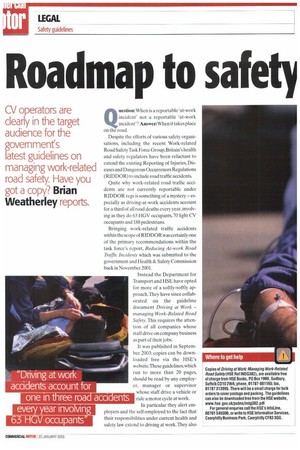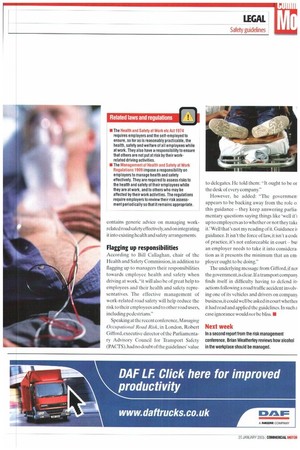Roadmap to safetv
Page 34

Page 37

If you've noticed an error in this article please click here to report it so we can fix it.
CV operators are clearly in the target audience for the government's latest guidelines on managing work-related road safety. Have you got a copy? Brian
Weatherley reports. CIuestion: When is a reportable 'at-work incident' not a reportable 'at-work incident'? Answer. When it takes place on the road. Despite the efforts of various safety organisations, including the recent Work-related Road Safety Task Force Group,Britain's health and safety regulators have been reluctant to extend the existing Reporting of Injuries, Diseases and Dangerous Occurrences Regulations (RIDDOR) to include road traffic accidents.
Quite why work-related road traffic accidents are not currently reportable under RIDDOR regs is something of a mystery — especially as driving-at-work accidents account for a third of all road deaths every year, involving as they do 63 HGV occupants, 70 light CV occupants and 188 pedestrians.
Bringing work-related traffic accidents within the scope of RIDDOR was certainly one of the primary recommendations within the task force's report, Reducing At-work Road Traffic Incidents which was submitted to the government and Health & Safety Commission back in November 2001.
Instead the Department for Transport and HSE have opted for more of a softly-softly approach.They have since collaborated on the guideline document Driving at Work — managing Work-Related Road Safety. This requires the attention of all companies whose staff drive on company business as part of their jobs.
It was published in September 2003; copies can be downloaded free via the HSE's website.These guidelines, which run to more than 20 pages, should be read by any employer, manager or supervisor whose staff drive a vehicle or ride a motor cycle at work.
In particular they alert employers and the self-employed to the fact that their responsibilities under current health and safety law extend to driving at work. They also contains generic advice on managing workrelated road safety effectively, and on integrating it into existing health and safety arrangements.
Flagging up responsibilities
According to Bill Callaghan, chair of the Health and Safety Commission, in addition to flagging up to managers their responsibilities towards employee health and safety when driving at work. "it will also be of great help to employees and their health and safety representatives. The effective management of work-related road safety will help reduce the risk to their employees and to other road users, including pedestrians."
Speaking at the recent conference, Managing Occupational Road Risk, in London, Robert Gifford, executive director of the Parliamentary Advisory Council for Transport Safety (PACTS ), had no doubt of the guidelines' value to delegates. He told them: "It ought to be or the desk of every company."
However, he added: "The governmen. appears to be backing away from the role o: this guidance — they keep answering parlia. mentary questions saying things like 'well in up to employers as to whether or not they take it.' Well that's not my reading of it. Guidance guidance. It isn't the force of law, it isn't a codt of practice. it's not enforceable in court — but an employer needs to take it into considera. tion as it presents the minimum that an em. ployer ought to be doing."
The underlying message from Gifford, if not the government, is clear. If a transport compan3 finds itself in difficulty having to defend it actions following a road traffic accident involving one of its vehicles and drivers on company business,it could well be asked in court whethei it had read and applied the guidelines. In such e case ignorance would not be bliss. •
Next week
In a second report from the risk management conference. Brian Weatherley reviews how alcohol in the workplace should be managed.












































































































































































































